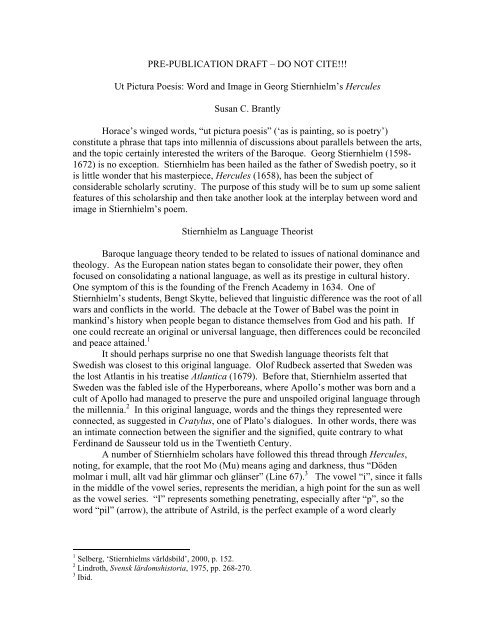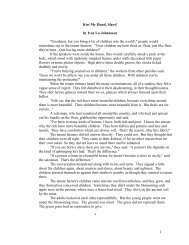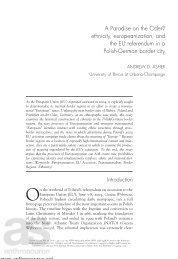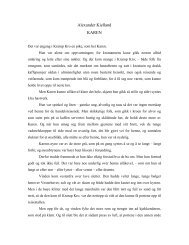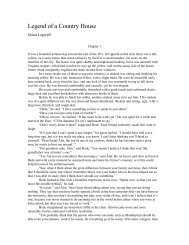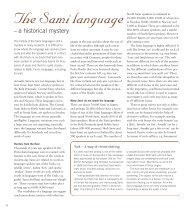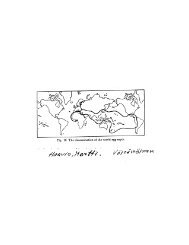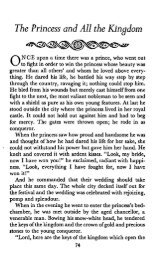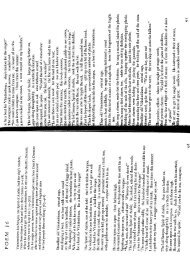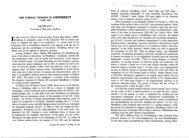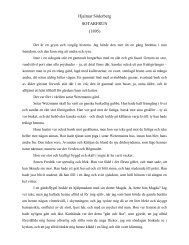Ut Pictura Poesis: Word and Image in Georg Stiernhielm's Hercules
Ut Pictura Poesis: Word and Image in Georg Stiernhielm's Hercules
Ut Pictura Poesis: Word and Image in Georg Stiernhielm's Hercules
You also want an ePaper? Increase the reach of your titles
YUMPU automatically turns print PDFs into web optimized ePapers that Google loves.
PRE-PUBLICATION DRAFT – DO NOT CITE!!!<br />
<strong>Ut</strong> <strong>Pictura</strong> <strong>Poesis</strong>: <strong>Word</strong> <strong>and</strong> <strong>Image</strong> <strong>in</strong> <strong>Georg</strong> Stiernhielm’s <strong>Hercules</strong><br />
Susan C. Brantly<br />
Horace’s w<strong>in</strong>ged words, “ut pictura poesis” (‘as is pa<strong>in</strong>t<strong>in</strong>g, so is poetry’)<br />
constitute a phrase that taps <strong>in</strong>to millennia of discussions about parallels between the arts,<br />
<strong>and</strong> the topic certa<strong>in</strong>ly <strong>in</strong>terested the writers of the Baroque. <strong>Georg</strong> Stiernhielm (1598-<br />
1672) is no exception. Stiernhielm has been hailed as the father of Swedish poetry, so it<br />
is little wonder that his masterpiece, <strong>Hercules</strong> (1658), has been the subject of<br />
considerable scholarly scrut<strong>in</strong>y. The purpose of this study will be to sum up some salient<br />
features of this scholarship <strong>and</strong> then take another look at the <strong>in</strong>terplay between word <strong>and</strong><br />
image <strong>in</strong> Stiernhielm’s poem.<br />
Stiernhielm as Language Theorist<br />
Baroque language theory tended to be related to issues of national dom<strong>in</strong>ance <strong>and</strong><br />
theology. As the European nation states began to consolidate their power, they often<br />
focused on consolidat<strong>in</strong>g a national language, as well as its prestige <strong>in</strong> cultural history.<br />
One symptom of this is the found<strong>in</strong>g of the French Academy <strong>in</strong> 1634. One of<br />
Stiernhielm’s students, Bengt Skytte, believed that l<strong>in</strong>guistic difference was the root of all<br />
wars <strong>and</strong> conflicts <strong>in</strong> the world. The debacle at the Tower of Babel was the po<strong>in</strong>t <strong>in</strong><br />
mank<strong>in</strong>d’s history when people began to distance themselves from God <strong>and</strong> his path. If<br />
one could recreate an orig<strong>in</strong>al or universal language, then differences could be reconciled<br />
<strong>and</strong> peace atta<strong>in</strong>ed. 1<br />
It should perhaps surprise no one that Swedish language theorists felt that<br />
Swedish was closest to this orig<strong>in</strong>al language. Olof Rudbeck asserted that Sweden was<br />
the lost Atlantis <strong>in</strong> his treatise Atlantica (1679). Before that, Stiernhielm asserted that<br />
Sweden was the fabled isle of the Hyperboreans, where Apollo’s mother was born <strong>and</strong> a<br />
cult of Apollo had managed to preserve the pure <strong>and</strong> unspoiled orig<strong>in</strong>al language through<br />
the millennia. 2 In this orig<strong>in</strong>al language, words <strong>and</strong> the th<strong>in</strong>gs they represented were<br />
connected, as suggested <strong>in</strong> Cratylus, one of Plato’s dialogues. In other words, there was<br />
an <strong>in</strong>timate connection between the signifier <strong>and</strong> the signified, quite contrary to what<br />
Ferd<strong>in</strong><strong>and</strong> de Sausseur told us <strong>in</strong> the Twentieth Century.<br />
A number of Stiernhielm scholars have followed this thread through <strong>Hercules</strong>,<br />
not<strong>in</strong>g, for example, that the root Mo (Mu) means ag<strong>in</strong>g <strong>and</strong> darkness, thus “Döden<br />
molmar i mull, allt vad här glimmar och glänser” (L<strong>in</strong>e 67). 3 The vowel “i”, s<strong>in</strong>ce it falls<br />
<strong>in</strong> the middle of the vowel series, represents the meridian, a high po<strong>in</strong>t for the sun as well<br />
as the vowel series. “I” represents someth<strong>in</strong>g penetrat<strong>in</strong>g, especially after “p”, so the<br />
word “pil” (arrow), the attribute of Astrild, is the perfect example of a word clearly<br />
1 Selberg, ‘Stiernhielms världsbild’, 2000, p. 152.<br />
2 L<strong>in</strong>droth, Svensk lärdomshistoria, 1975, pp. 268-270.<br />
3 Ibid.
mirror<strong>in</strong>g the th<strong>in</strong>g to which it refers. 4 The “i” <strong>in</strong> the word’s center becomes the po<strong>in</strong>t of<br />
the arrow.<br />
Figure Poetry<br />
The Baroque passion for connect<strong>in</strong>g words with the th<strong>in</strong>gs they represent also<br />
manifested itself <strong>in</strong> figure poems. Anyone glanc<strong>in</strong>g through a literary history of the<br />
Baroque is likely to stumble upon an illustration of a figure poem, such as, a funeral<br />
poem that takes the shape of the grim reaper or a wedd<strong>in</strong>g poem <strong>in</strong> the shape of a goblet.<br />
Draw<strong>in</strong>g pictures with words is a means of unit<strong>in</strong>g form <strong>and</strong> content. 5 In the Twentieth<br />
Century, concrete poets resorted to similar measures, as they sought to make word <strong>and</strong><br />
th<strong>in</strong>g unite. A good example is the follow<strong>in</strong>g poem by Eugene Gomr<strong>in</strong>ger from 1954:<br />
silencio silencio silencio<br />
silencio silencio silencio<br />
silencio silencio<br />
silencio silencio silencio<br />
silencio silencio silencio<br />
Curiously, the feature of the poem that best represents silence is the space <strong>in</strong> the middle.<br />
Every utterance of “silencio” breaks the silence.<br />
Stiernhielm may have been way ahead of Gomr<strong>in</strong>ger. <strong>Hercules</strong> is comprised of<br />
521 l<strong>in</strong>es of dactylic hexameter, or, more accurately, 520. After the famous Death<br />
sermon, a partial l<strong>in</strong>e occurs:<br />
Hwar blifwr all wår Lust? När Krop och Siäl äre skilde.<br />
I thet mörke ewiga Tysta! (L<strong>in</strong>es 77, 78)<br />
This l<strong>in</strong>e caused Bernt Olsson to exclaim: ”Här har diktaren <strong>in</strong>te ens formått att göra<br />
versen fullständig?” 6 In the context of the poem, however, this <strong>in</strong>complete l<strong>in</strong>e creates a<br />
silence, a space follow<strong>in</strong>g the word “Tysta” (silence) that illustrates its mean<strong>in</strong>g.<br />
Moreover the abruptly cut off l<strong>in</strong>e, can be read <strong>in</strong> analogy to the life that is suddenly cut<br />
off by death.<br />
The f<strong>in</strong>al l<strong>in</strong>e of “<strong>Hercules</strong>” has been a source of discord among scholars: “Döden<br />
är yttersta målet, i dy vij samkas, och ändas” (L<strong>in</strong>e 521). Sten L<strong>in</strong>droth <strong>and</strong> Sven<br />
Delblanc have cordially disputed whether or not the poem <strong>Hercules</strong> supports pagan or<br />
Christian sentiments. 7 “Death is the end” is almost a cliché, but can be taken to mean<br />
that there is no life after death, although there are other references to an afterlife<br />
elsewhere <strong>in</strong> the poem. What if, however, Stiernhielm simply wanted to end his poem<br />
with the word “ändas” ([We] are ended)? Once aga<strong>in</strong>, the word <strong>and</strong> the th<strong>in</strong>g itself<br />
would co<strong>in</strong>cide.<br />
4 Ståhle, ‘Språkteori och ordval i Stiernhielms författarskap’, 1951, 76<br />
5 Mödersheim, ‘Text als Bild’, 2002, 73.<br />
6 Olsson, Den svenska skaldekonstens fader och <strong>and</strong>ra Stiernhielmsstudier, 1973, p. 136.<br />
7 Delblanc, ‘<strong>Hercules</strong> magnanimus’, 1961, <strong>and</strong> L<strong>in</strong>droth, ‘<strong>Hercules</strong>’, 1967, p. 356.
Another example of Stiernhielm mak<strong>in</strong>g his words mesh with the th<strong>in</strong>g described<br />
is <strong>in</strong> the passage where the dress of Flättia is described:<br />
Hon war klädd vppå Fransk där-å alt var brokot och krokot;<br />
R<strong>in</strong>gat och sl<strong>in</strong>gat i kors; med Franssar i Lyckior, och nyckior,<br />
Pappat och knappat i längd, och i bredd; med spistar och litsor.<br />
Rundt omkr<strong>in</strong>g, och i r<strong>in</strong>g, ala-mode, beflittrat, och splittrat. (L<strong>in</strong>es 34-37)<br />
The sudden <strong>in</strong>crease <strong>in</strong> <strong>in</strong>ternal rhyme, repetition, <strong>and</strong> verbal ornament replicates the<br />
ornateness of Flättia’s dress. Stiernhielm achieves poetically what Flättia’s dressmaker<br />
does with lace, needle <strong>and</strong> thread. Although <strong>Hercules</strong> is certa<strong>in</strong>ly not a figure poem that<br />
pa<strong>in</strong>ts an obvious picture like a goblet, these examples display a similar dynamic <strong>in</strong>herent<br />
<strong>in</strong> the genre. The words that describe a th<strong>in</strong>g emulate the th<strong>in</strong>g itself.<br />
Emblems<br />
Emblems were enormously popular dur<strong>in</strong>g the Baroque <strong>and</strong> provided yet another<br />
opportunity for the <strong>in</strong>terplay of word <strong>and</strong> image. The classic emblem consists of three<br />
parts: <strong>in</strong>scriptio, pictura, <strong>and</strong> subscriptio. The <strong>in</strong>scription consists of a motto, which is<br />
then illustrated by an allegorical picture. The subscript expla<strong>in</strong>s the correct connection<br />
between the motto <strong>and</strong> the picture to the viewer. Often these emblems have a moral<br />
lesson to impart, <strong>and</strong> <strong>in</strong>volv<strong>in</strong>g the viewer <strong>in</strong> the decod<strong>in</strong>g of the image was deemed<br />
pedagogically effective. In 1663, J.G. Schottelius claimed that the picture <strong>in</strong> an emblem<br />
was equal to the body, <strong>and</strong> the words with the soul. 8 In Protestant countries, words were<br />
given priority over pictures. 9 The author of an emblem was the one who wrote the words<br />
to accompany the picture. 10 The artists who created the pictures were considered so<br />
<strong>in</strong>consequential that their names were not often preserved. Stiernhielm did not feel the<br />
need to employ an artist, consider<strong>in</strong>g his words sufficient to pa<strong>in</strong>t the picture.<br />
Axel Friberg has done a study of the emblems <strong>in</strong> <strong>Hercules</strong>. L<strong>in</strong>es 354 to 365<br />
describe the Ox-to-the-slaughter emblem (Figure 1) found <strong>in</strong> Jacob Cats’ hugely popular<br />
collection, S<strong>in</strong>ne- en m<strong>in</strong>nesbeelden (1627). 11 Fru Dygd first pa<strong>in</strong>ts the picture verbally,<br />
describ<strong>in</strong>g the ox fattened <strong>and</strong> bedecked with flowers, lead <strong>in</strong> a festive procession. Then<br />
the explication ensues, the ox must pay for its pleasures with a terrible death, just as the<br />
youth engaged <strong>in</strong> drunkenness <strong>and</strong> social pleasures will pay the same price. L<strong>in</strong>es 255 to<br />
259 describe a spider web emblem (Figure 2) which Friberg traces to Joachim Camerarii,<br />
although this emblem is also <strong>in</strong> the same Cats collection as the previous emblem. 12 This<br />
time Fru Lusta verbally pa<strong>in</strong>ts the picture of a spider web <strong>in</strong> which mosquitoes become<br />
ensnared, but wasps escape. Fru Lusta supplies the explanation that the spider web is like<br />
the law; the poor <strong>and</strong> unfortunate are caught, but the powerful go free. Because this<br />
explanation is given by Fru Lusta, the reader needs to question the value of a moral<br />
8<br />
Mödersheim, ‘Emblem, Emblematik’, 1994, 1104-5.<br />
9<br />
Schuster, ‘Abstraktion, Agitation und E<strong>in</strong>füllung’, 1983, p. 116.<br />
10<br />
Mödersheim, ‘Dom<strong>in</strong>i Doctr<strong>in</strong>a Coronat’: Die geistliche Emblematik Daniel Cramers (1568-1637),<br />
1994, p. 20.<br />
11<br />
Friberg, Den svenske <strong>Hercules</strong>, 1945, p. 66.<br />
12 Ibid., 63.
lesson com<strong>in</strong>g from such a source. Such th<strong>in</strong>gs may <strong>in</strong>deed happen <strong>in</strong> the world, but that<br />
does not mean they are right. Lusta is urg<strong>in</strong>g <strong>Hercules</strong> to take advantage of his social<br />
st<strong>and</strong><strong>in</strong>g <strong>and</strong> do what he wants, because the law will not punish him. This is a temptation<br />
our hero needs to reject.<br />
Friberg seems to have overlooked another emblem, strangely, s<strong>in</strong>ce it also comes<br />
from the Cats collection. This emblem (Figure 3) occurs at the end of <strong>Hercules</strong>, L<strong>in</strong>es<br />
496 to 520. Fru Dygd describes a house <strong>in</strong> an advanced state of decay, overgrown <strong>and</strong><br />
ab<strong>and</strong>oned, <strong>and</strong> then follows the explanation: “Sådan är Menniskio kropp: när åldren<br />
kommer, och åhren. (L<strong>in</strong>e 507)” Fru Dygd goes on to describe the decay of the flesh, as<br />
one becomes bent, bald, toothless, deaf, bl<strong>in</strong>d <strong>and</strong> senile. The orig<strong>in</strong>al emblem <strong>in</strong><br />
question juxtaposes a derelict house with an ag<strong>in</strong>g man ly<strong>in</strong>g <strong>in</strong> what seems to be a grave.<br />
Bernt Olsson traces the source of these images <strong>in</strong> Stiernhielm to Ecclesiastes 12, 13 the<br />
orig<strong>in</strong>al source of the w<strong>in</strong>ged words: “Vanity of vanities […] All is vanity!” (12:9) The<br />
Vanitas theme was much beloved by the baroque <strong>and</strong> a suitable note upon which to end<br />
the poem.<br />
Invok<strong>in</strong>g these familiar emblems serves several purposes <strong>in</strong> terms of Baroque<br />
aesthetics. First, Stiernhielm can engage <strong>in</strong> the approved <strong>and</strong> admired practice of<br />
imitation. Petrarch suggested that the poet should resemble a bee that dr<strong>in</strong>ks nectar from<br />
as many flowers as possible, <strong>and</strong> hence, the more references to other sources the better.<br />
Secondly, Stiernhielm can engage his audience <strong>in</strong> the familiar practice of extract<strong>in</strong>g<br />
moral lessons from art. Thirdly, he can draw on multiple art forms. The Baroque thrived<br />
on comb<strong>in</strong><strong>in</strong>g art forms, the acme of which became the opera <strong>and</strong> ballet. Lastly,<br />
Stiernhielm is able to draw with words, attempt to br<strong>in</strong>g the word <strong>and</strong> image closer<br />
together.<br />
The Appearance of Vice <strong>and</strong> Virtue<br />
The <strong>in</strong>spiration of Stiernhielm’s poem is the story of <strong>Hercules</strong> at the crossroads,<br />
which can be traced back to Xenophon’s Memorabilia. <strong>Hercules</strong> is approached by the<br />
<strong>in</strong>carnations of Vice <strong>and</strong> Virtue <strong>and</strong> asked to choose which path he should follow. This<br />
theme has lived a long <strong>and</strong> happy life <strong>in</strong> art history as evidenced <strong>in</strong> Erw<strong>in</strong> Panofsky’s<br />
weighty tome on the topic. 14 The Baroque, <strong>in</strong> particular, seemed to love the theme<br />
because of its fondness for b<strong>in</strong>ary oppositions (vice/virtue, war/peace, strength/wisdom,<br />
etc.) <strong>and</strong> the opportunity for moral education. Stiernhielm is, at the same time,<br />
respectfully imitative of the literary <strong>and</strong> artistic tradition he allies himself with, <strong>and</strong><br />
dist<strong>in</strong>ctly <strong>in</strong>dependent with his own lesson to teach. The physical appearance of both<br />
Vice <strong>and</strong> Virtue speaks volumes about what they represent.<br />
Virtue is often depicted as a lovely goddess, but Stiernhielm’s Fru Dygd is “Brun<br />
vnder ögon’, och bränd av Sool-skijn, mager af hulde;” (L<strong>in</strong>e 279) She is dressed<br />
cleanly <strong>and</strong> “på dät ährlige gamble maneret” (L<strong>in</strong>e 281). Olsson has found a model for<br />
Virtue as an old-fashioned Germanic matron <strong>in</strong> Moscherosch’s Wundersame Geschichte<br />
Phil<strong>and</strong>ers von Sittewald (1640-3), <strong>in</strong> which sensible Germanic virtues are set aga<strong>in</strong>st<br />
frivolous à la mode <strong>in</strong>fluences from France. 15 For Moscherosh, Vice is French, <strong>and</strong><br />
13 Olsson, Den svenska skaldekonstens fader och <strong>and</strong>ra Stiernhielmsstudier, 1973, p. 136.<br />
14 Panofsky, <strong>Hercules</strong> am Scheidewege und <strong>and</strong>ere antike Bildstoffe <strong>in</strong> her neueren Kunst, 1997.<br />
15 Olsson, Den svenska skaldekonstens fader och <strong>and</strong>ra Stiernhielmsstudier, 1973, p. 77.
Virtue is a matron <strong>in</strong> old-fashioned German dress, tanned by the sun. Like Moscherosch,<br />
Stiernhielm was deeply concerned about foreign <strong>in</strong>fluences, particularly French.<br />
Stiernhielm clearly has someth<strong>in</strong>g quite similar to Moscherosch’s German/French<br />
conflict <strong>in</strong> m<strong>in</strong>d when he pits Fru Dygd aga<strong>in</strong>st Fru Lusta. In his defense of the Swedish<br />
language, Gambla Swea- och Götha-Måles fatebur (1643), Stiernhielm depicts the<br />
Swedish language as a Germanic matron who dresses <strong>in</strong> ill-sitt<strong>in</strong>g à la mode dress. The<br />
image was meant to protest the use of foreign loan words <strong>in</strong> Swedish; the foreign<br />
cloth<strong>in</strong>g, like the foreign words, only mar the dignity of the pure, noble language. Opitz<br />
<strong>in</strong> Aristarchus (1617) had depicted the German language as a maiden, so the idea was,<br />
like so much <strong>in</strong> the Baroque, not new. However, the image of Fru Dygd as a respectable<br />
matron comb<strong>in</strong>es the allegory of <strong>Hercules</strong> at the crossroads with Stiernhielm’s own<br />
<strong>in</strong>terest <strong>in</strong> preserv<strong>in</strong>g the Swedish language from foreign <strong>in</strong>fluence.<br />
There is a long tradition stretch<strong>in</strong>g all the way back to Xenophon of depict<strong>in</strong>g<br />
Vice hardly wear<strong>in</strong>g anyth<strong>in</strong>g at all, but a th<strong>in</strong> veil. Lusta’s daughter, Kättia, sports this<br />
look <strong>in</strong> Stiernhielm’s poem: “Klädd war hon i fijnt Skijr; at hon synts hwart klädd, eller<br />
oklädd (L<strong>in</strong>e 25)”. 16 Fru Lusta is dressed <strong>in</strong> foreign luxury, decked <strong>in</strong> multi-colored<br />
clothes with pearls, gold, <strong>and</strong> jewels. She presents her case to <strong>Hercules</strong> with the skills of<br />
a classic rhetorician, 17 tempt<strong>in</strong>g him with a myriad of foreign <strong>in</strong>fluences. She provides a<br />
lengthy book list of light read<strong>in</strong>g, <strong>in</strong>clud<strong>in</strong>g Rabelais. The read<strong>in</strong>g list is followed by a<br />
list of card games with names like “La-bete.” Fru Lusta urges <strong>Hercules</strong> to practice<br />
danc<strong>in</strong>g <strong>in</strong>stead of practic<strong>in</strong>g arms, <strong>and</strong> if he must wage war, he should do so <strong>in</strong> a bar<br />
accompanied by friends like “Sauf-du-Re<strong>in</strong>-aus Hans” while dr<strong>in</strong>k<strong>in</strong>g German w<strong>in</strong>e <strong>and</strong><br />
beer, “och Fransk Wijn i nödfall” (L<strong>in</strong>e 214). Tobacco from Virg<strong>in</strong>ia is another vice he<br />
might try.<br />
It is worthy of note that Fru Lusta’s speech is, of necessity, riddled with loan<br />
words. Her speech itself is as strewn with foreign jewels, as her person. Quite the<br />
opposite is true of Fru Dygd. Obvious loan words are banished once she beg<strong>in</strong>s to speak.<br />
Sven Delblanc spends a good part of his essay on <strong>Hercules</strong> restor<strong>in</strong>g the Lat<strong>in</strong> names to<br />
the virtues that Fru Dygd enumerates. 18 It is significant that Fru Dygd does not resort to<br />
Lat<strong>in</strong>. These virtues are presented as solid Swedish virtues, so, of course, they must be<br />
expressed <strong>in</strong> Swedish. Fru Lusta <strong>and</strong> Fru Dygd are simultaneously representatives of<br />
Vice <strong>and</strong> Virtue, à la mode frivolity <strong>and</strong> Swedish sense, as well as <strong>in</strong>carnations of foreign<br />
loan words versus purity of speech.<br />
Another remarkable feature of Fru Lusta’s appearance is her blond hair, which<br />
literary tradition gives as brown. Hjalmar L<strong>in</strong>droth helpfully suggested that this is simply<br />
the renaissance ideal of fem<strong>in</strong><strong>in</strong>e beauty. 19 It may be possible, however, to be more<br />
specific about which renaissance beauty <strong>in</strong>spired Fru Lusta’s hairstyle. When Prague fell<br />
to the Swedes <strong>in</strong> 1648, Veronese’s “Allegory of Virtue <strong>and</strong> Vice (The Choice of<br />
<strong>Hercules</strong>) came to the court of Queen Christ<strong>in</strong>a as the spoils of war (Figure 4). 20 At<br />
about this time, Stiernhielm was actively engaged <strong>in</strong> the artistic life of the court, hav<strong>in</strong>g<br />
penned texts for the Queen’s ballets, Den fångne Cupido (1649) <strong>and</strong> Freds-afl (1649).<br />
16 Olsson, Den svenska skaldekonstens fader och <strong>and</strong>ra Stiernhielmsstudier, 1973, p. 87.<br />
17 Hansson, Från <strong>Hercules</strong> till Swea. Den litterära textens förändr<strong>in</strong>gar, 2000, pp. 16-19.<br />
18 Delblanc, ‘<strong>Hercules</strong> magnanimus,’ 1961, pp. 52-58.<br />
19 L<strong>in</strong>droth, Stiernhielms <strong>Hercules</strong>. En diktmonografi, 1913, p. 43.<br />
20 The Frick Collection: An Illustrated Catalogue, 1968, p. 280.
Veronese’s Fru Lusta is most certa<strong>in</strong>ly blond, <strong>and</strong>, accord<strong>in</strong>g to Panofsky, <strong>in</strong>fluenced<br />
many subsequent illustrators of the <strong>Hercules</strong>-at-the-crossroads motif. 21 A different<br />
version of the same theme by Veronese, “A Boy from the Sanuto Family Between Virtue<br />
<strong>and</strong> Vice”, is clearly the <strong>in</strong>spiration for the illustration of Fru Lusta that appeared with the<br />
first published edition of Stiernhielm’s poem, possibly via the imitations of Paulus Potter<br />
<strong>and</strong> Jan Victors. Lusta’s hair is described <strong>in</strong> the poem as: ”Gull-gåhl-blänk<strong>and</strong>es Håår,<br />
bekrönt medh Roser i Pärlor”(L<strong>in</strong>e 11)” In the pa<strong>in</strong>t<strong>in</strong>g that came to Christ<strong>in</strong>a’s court,<br />
Vice’s face is not visible, only blond hair adorned with a circlet of white roses.<br />
Another feature that Stiernhielm’s poem has <strong>in</strong> common with Veronese’s pa<strong>in</strong>t<strong>in</strong>g<br />
is the fact that <strong>Hercules</strong> is depicted as a young nobleman, without the signature lion sk<strong>in</strong><br />
<strong>and</strong> club. In artistic render<strong>in</strong>gs of the <strong>Hercules</strong> motif, it is fairly common to depict<br />
<strong>Hercules</strong> <strong>in</strong> the likeness of a nobleman or emperor, but usually still a carry<strong>in</strong>g club <strong>and</strong><br />
lion sk<strong>in</strong>. Stiernhielm has omitted these details with strik<strong>in</strong>g deliberation. Virtually<br />
every other character <strong>in</strong> the poem is dressed <strong>in</strong> heavy symbolism, <strong>and</strong> their appearance is<br />
pa<strong>in</strong>stak<strong>in</strong>gly described. Stiernhielm’s <strong>Hercules</strong> is, by comparison, a blank page. All we<br />
know is that he is a young nobleman. Perhaps this makes it easier for young noblemen <strong>in</strong><br />
the audience to read themselves <strong>in</strong>to the role of <strong>Hercules</strong>. Whether or not this decision<br />
was <strong>in</strong>spired by Veronese or Stiernhielm’s <strong>in</strong>tention all along is impossible to ascerta<strong>in</strong><br />
from earlier drafts of the poem. The parallel is nonetheless strik<strong>in</strong>g.<br />
Ballet<br />
In <strong>Hercules</strong>, after Fru Lusta has been <strong>in</strong>troduced, her four children step forward <strong>in</strong><br />
turn, carry<strong>in</strong>g allegorical attributes that clearly <strong>in</strong>dicate their true natures. Lättia (Sloth)<br />
is carry<strong>in</strong>g a pillow under one arm <strong>and</strong> a deck of cards. Her cloth<strong>in</strong>g is soiled <strong>and</strong> her<br />
hair is decorated with soporific herbs, such as poppies. These attributes clearly mark her<br />
as laz<strong>in</strong>ess, who either sleeps too much or kills time play<strong>in</strong>g cards. Her sister Kättia<br />
(Lust) is scantily clad <strong>and</strong> carries the tools for build<strong>in</strong>g a fire...the flames of passion, no<br />
doubt. Flättia (Frivolity) both laughs <strong>and</strong> cries, dances, wears à la mode dress, <strong>and</strong><br />
carries a sailboat without a rudder, the perfect emblem of the directionless. F<strong>in</strong>ally Ruus<br />
(Intoxication) steps forward, fat, breathless, <strong>and</strong> rosy-cheeked with grapes <strong>and</strong> hops <strong>in</strong> his<br />
hair, a glass <strong>in</strong> h<strong>and</strong>, <strong>and</strong> a pipe stuck <strong>in</strong> his wreath.<br />
A number of critics have noted that this chorus l<strong>in</strong>e of children seems taken<br />
directly from the allegorical ballets of the ilk produced <strong>in</strong> Christ<strong>in</strong>a’s court. 22 Such<br />
ballets were essentially like mov<strong>in</strong>g emblems. The plot of the ballet was enacted<br />
(M<strong>in</strong>erva vanquish<strong>in</strong>g Mars, for example), <strong>and</strong> the characters usually possessed<br />
allegorical attributes that could identify them <strong>and</strong> their functions. Viewers generally had<br />
a program that would expla<strong>in</strong> the allegory <strong>in</strong> verses written <strong>in</strong> several languages,<br />
function<strong>in</strong>g essentially like the subscript of the traditional emblem. Stiernhielm<br />
contributed such program texts for both Den fångne Cupido (1649) <strong>and</strong> Freds-afl (1649).<br />
A philological detail that would tend to support the assumption that Stiernhielm’s work<br />
on these ballets <strong>in</strong>fluenced his portrayals of Lusta’s children is the fact that the early<br />
version of <strong>Hercules</strong> written down by Johan Ekeblad does not conta<strong>in</strong> a description of the<br />
21 Panofsky, <strong>Hercules</strong> am Scheidewege, 1997, pp. 122-23.<br />
22 Dahlberg, ‘Danss’ är een ädele konst. Om Stiernhielm och hovbaletten’, 2000, p. 41; Beijer, ‘Den<br />
teaterhistoriska bakgrunden till Spelet om Herculis Wägewal’, 1955, p. 95.
children. Exact dat<strong>in</strong>g of Ekeblad’s version has proven quite the challenge, but a likely<br />
chronology would place it before Stiernhielm’s <strong>in</strong>volvement <strong>in</strong> Christ<strong>in</strong>a’s ballets.<br />
Therefore, the idea of the allegorical children came to him after watch<strong>in</strong>g the ballets.<br />
Samuel Columbus, <strong>in</strong> any event, noted the likeness between Stiernhielm’s<br />
<strong>Hercules</strong> <strong>and</strong> public performance. He later adapted the poem <strong>in</strong>to Spel om <strong>Hercules</strong><br />
Wägewal (1687), for which he added some l<strong>in</strong>es for <strong>Hercules</strong>, allegorical figures to<br />
accompany Fru Dygd, <strong>and</strong> a number of songs. The addition of music to the drama turns<br />
the play <strong>in</strong>to the universal art form that the Baroque so admired, <strong>in</strong>corporat<strong>in</strong>g literature,<br />
music, pa<strong>in</strong>t<strong>in</strong>g, <strong>and</strong> dance.<br />
Conclusion<br />
Stiernhielm’s <strong>Hercules</strong> is <strong>in</strong> many was the epitome of Baroque aesthetic taste <strong>in</strong><br />
Swedish literature. Stiernhielm overwhelms <strong>and</strong> astonishes his reader, like the Italian<br />
Mar<strong>in</strong>ists would have it, with his poetic virtuosity, his catalogues, his emblems,<br />
attributes, <strong>and</strong> images. He is the busy bee of Petrarch draw<strong>in</strong>g from Xenophon as well as<br />
numerous other sources, both textual <strong>and</strong> visual, thus deliberately blend<strong>in</strong>g art forms. The<br />
antithesis he presents is multi-layered: Vice versus Virtue, French <strong>in</strong>fluence versus<br />
Swedish sense, <strong>and</strong> loan words versus a pure Swedish. He morally educates his<br />
audience, urg<strong>in</strong>g them, like <strong>Hercules</strong> to choose virtue over vice. In the mood of Baroque<br />
nationalism, he seeks to demonstrate by unit<strong>in</strong>g word <strong>and</strong> image that Swedish is, truly,<br />
the orig<strong>in</strong>al language that says what it means.<br />
References<br />
Beijer, Agne. ‘Den teaterhistoriska bakgrunden till Spelet om Herculis Wägewal’. Spel<br />
om Herculis Wägewal av <strong>Georg</strong> Stiernhielm och Samuel Columbus.. Eds. Agne<br />
Beijer <strong>and</strong> Elias Wessén. Stockholm: Bonniers, 1955. Pp. 67-126.<br />
Dahlberg, Gunilla. ‘Danss’ är een ädele konst. Om Stiernhielm och hovbaletten’.<br />
Stiernhielm 400 år. Föredrag vid <strong>in</strong>ternaltionellt symposium i Tartu 1998. Eds.<br />
Stig Örjan-Ohlsson <strong>and</strong> Bernt Olsson. Stockholm: Almqvist &Wiksell, 2000. Pp.<br />
23-46.<br />
Delblanc, Sven. ‘<strong>Hercules</strong> magnanimus.’ Samlaren 82(1961): 3-72.<br />
Hansson, St<strong>in</strong>a. Från <strong>Hercules</strong> till Swea. Den litterära textens förändr<strong>in</strong>gar.<br />
Gothenburg: The Dept. of Literature at the University of Gothenburg, 2000.<br />
Friberg, Axel. Den svenske Herculse: Studier I Stiernhielms diktn<strong>in</strong>g. Stockholm:<br />
Walhlström & Widstr<strong>and</strong>, 1945.<br />
The Frick Collection: An Illustrated Catalogue, vol. 2. New York: The Frick Collection,<br />
1968.<br />
L<strong>in</strong>droth, Hjalmar. Stiernhielms <strong>Hercules</strong>. En diktmonografi. Lund: C.W. K. Gleerups<br />
förlag, 1913.<br />
L<strong>in</strong>droth, Sven. ‘<strong>Hercules</strong>’. Ny illustrerad svensk litteraturhistoria, vol. 1. ed. E.N.<br />
Tigerstedt. Stockholm: Natur och Kultur, 1967. Pp. 353-357.<br />
-----. Svensk lärdomshistoria. Stormaktstiden. Stockholm: Norstedts, 1975.<br />
Mödersheim, Sab<strong>in</strong>e. ‘Dom<strong>in</strong>i Doctr<strong>in</strong>a Coronat’: Die geistliche Emblematik Daniel
Cramers (1568-1637). Frankfurt: Peter Lang, 1994.<br />
-----. ‘Emblem, Emblematik’. Historisches Wörterbuch der Rhetorik, vol. 2. Ed Gerd<br />
Ued<strong>in</strong>g. Tüb<strong>in</strong>gen: Niemeyer, 1994. 1994, 1098-1108..<br />
-----. ‘Text als Bild-Bild als Text. Figurengedicht und Emblematik’. Emblem Studies <strong>in</strong><br />
the Honor of Peter M. Daly. Eds. Michael Bath, Pedro F. Campa, Daniel Russel.<br />
Baden-Baden: Körner, 2002. Pp. 169-190.<br />
Olsson, Bernt. Den svenska skaldekonstens fader och <strong>and</strong>ra Stiernhielmsstudier. Skrifter<br />
utgivna av Vetenskapssocieteten i Lund, vol 69. Lund: Gleerup, 1973.<br />
Panofsky, <strong>Hercules</strong> am Scheidewege und <strong>and</strong>ere antike Bildstoffe <strong>in</strong> her neueren Kunst.<br />
Berl<strong>in</strong>: Gebr. Mann Verlag, 1997. (Orig<strong>in</strong>ally 1930)<br />
Schuster, Peter-Klaus. ‘Abstraktion, Agitation und E<strong>in</strong>füllung. Formen protestantischer<br />
Kunst im 16. Jahrhundert’. Luther und die Folgen für die Kunst. Ed. Verner<br />
Hoffman. Munich: Prestel-Verlag, 1983. Pp. 115-266.<br />
Selberg, Erl<strong>and</strong>. ‘Stiernhielms världsbild’. Stiernhielm 400 år. Föredrag vid<br />
<strong>in</strong>ternaltionellt symposium i Tartu 1998. Eds. Stig Örjan-Ohlsson <strong>and</strong> Bernt<br />
Olsson. Stockholm: Almqvist &Wiksell, 2000. Pp. 137-158.<br />
Stiernhielm, <strong>Georg</strong>. Samlade Skrifter, vol. 1. Ed. Johan Nordström. Stockholm: Albert<br />
Bonniers Förlag, 1929.<br />
Ståhle, Carl Ivar. ‘Språkteori och ordval i Stiernhielms författarskap’. Arkiv för Nordisk<br />
Filologi 66(1951): 52-94.<br />
Illustration captions:<br />
Figure 1: From Jacob Cats, S<strong>in</strong>ne- en m<strong>in</strong>nebilden (1627). Emblem Project <strong>Ut</strong>recht,<br />
2002.<br />
Figure 2: From Jacob Cats, S<strong>in</strong>ne- en m<strong>in</strong>nebilden (1627). Emblem Project <strong>Ut</strong>recht,<br />
2002.<br />
Figure 3: From Jacob Cats, S<strong>in</strong>ne- en m<strong>in</strong>nebilden (1627). Emblem Project <strong>Ut</strong>recht,<br />
2002.<br />
Figure 4: Veronese’s Allegory of Virtue <strong>and</strong> Vice (The Choice of <strong>Hercules</strong>). Copyright<br />
The Frick Collection, New York.


